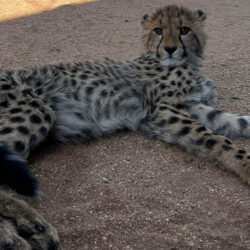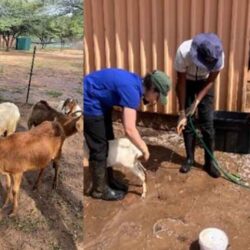The “Daily Routine” at CCF is a Whirlwind
-

- by Kristen Morris July 22, 2014

Getting ready to leave Namibia after two months seems unreal. It seems like only yesterday I got off my first-ever plane ride to Africa, jumped into my first-ever taxi, and rode down the dusty road to the CCF center. The drive down was ordinary; if ordinary includes seeing baboons and warthogs as you drive along the picturesque views. Little did I know as I was riding down how incredible the next few months were going to be. I have wanted to visit the Cheetah Conservation Fund and be involved in cheetah conservation for as long as I can remember. However, it wasn’t until I was entering my junior year at college that my dream would become a reality. I arrived at CCF on May 12th to begin my two month internship. It feels incredible to have accomplished this goal, but it feels even better to have met so many wonderful and interesting people during my stay. The days can be long and some of the jobs are not glamorous, but I would not trade this experience for anything.
One of the first things I got to experience here was taking care of a group of ten Anatolian puppies. The guarding dog program was one of the reasons I admired CCF before I arrived. It was an awesome experience to see the puppies grow and then watch as they went off with their new farmers to meet their livestock animals and begin their jobs protecting livestock and helping to save the cheetah.

The “daily routine” at CCF is a whirlwind of feeding cheetahs and dogs, cleaning enclosures, washing bowls and spoons, and doing various administrative tasks. I fortunately had a chance to participate in much of what CCF has to offer and far too much to record it all. One of my favorite tasks was helping to check and change some of the numerous camera traps around CCF’s property. While on the way to each location it was marvelous to see the wide variety of birds and mammals that live happily in and around CCF. While I was here I was also able to help prepare the International Cheetah Studbook. The Studbook is a record of the captive cheetah population and can help to determine trends and changes within the captive population. It was really interesting to see all of the different facilities around the world that kept cheetahs and shared their information with CCF.
One of the most exciting highlights of my trip was the release of two female cheetahs into the wild. Deborah and Zinzi, after receiving their certificate of health from the clinic, were released on CCF land to begin their life as wild cheetahs. One of the most amazing sights is watching as the wooden doors are raised up and the cheetahs look around briefly before taking off into the wilderness like lightning. Of course they are not truly alone as they are tracked and monitored by CCF’s dedicated husbandry team. The hot, and sometimes painful, tracking process pays off when you come upon a cat crouching in the tall grass or sometimes even a kill site.
My experience at CCF was as wonderful as I dreamed and more than I could ever have imagined. I have met many new people, staff and intern alike, who are incredibly friendly as well as knowledgeable. I will miss all of you and would like to thank you for all of your kindness and experience. I can’t wait to come back and continue my adventures in Namibia at The Cheetah Conservation Fund.
Related Reading
-
September 30, 2025
Brendy’s Story: Honoring My Dad with the Cheetah Conservation Fund -
December 3, 2023
Paws, Prints and DNA: Chronicles of a Genetics Intern




